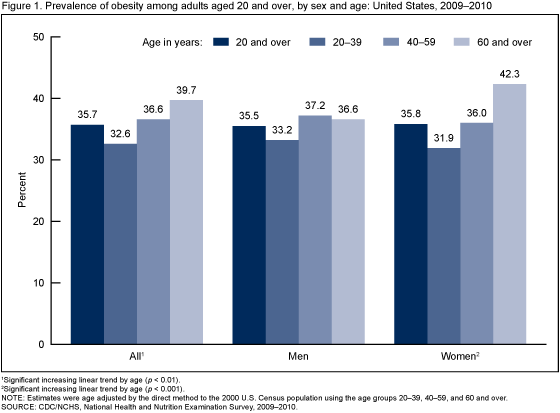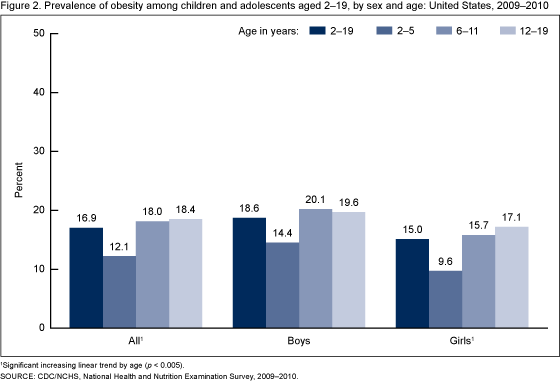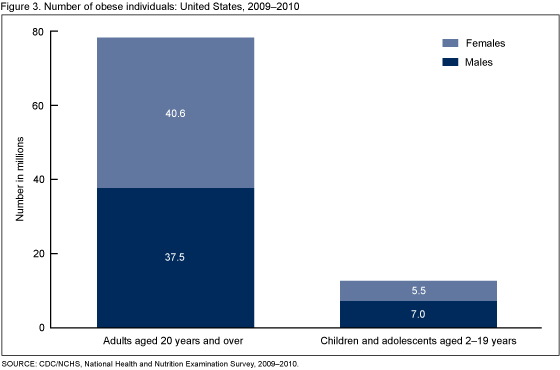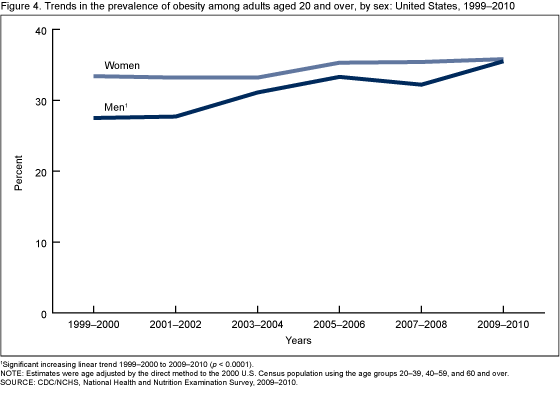Prevalence of Obesity in the United States, 2009–2010
On This Page
- Key findings
- In 2009–2010, 35.7% of U.S. adults were obese.
- In 2009–2010, 16.9% of U.S. children and adolescents were obese.
- In 2009–2010, over 78 million U.S. adults and about 12.5 million U.S. children and adolescents were obese.
- Between 1999–2000 and 2009–2010, the prevalence of obesity increased among men but not among women.
- Between 1999–2000 and 2009–2010, there was an increase in the prevalence of obesity among boys but not among girls.
- Summary
- Definition
- Data source and methods
- About the authors
- References
- Suggested citation
NCHS Data Brief No. 82, January 2012
PDF Version (528 KB)
Cynthia L. Ogden, Ph.D.; Margaret D. Carroll, M.S.P.H.; Brian K. Kit, M.D., M.P.H.; and Katherine M. Flegal, Ph.D.
Key findings
Data from the National Health and Nutrition Examination Survey, 2009–2010
- More than one-third of adults and almost 17% of youth were obese in 2009–2010.
- There was no change in the prevalence of obesity among adults or children from 2007–2008 to 2009–2010.
- Obesity prevalence did not differ between men and women.
- Adults aged 60 and over were more likely to be obese than younger adults.
Obesity increases the risk of a number of health conditions including hypertension, adverse lipid concentrations, and type 2 diabetes (1). The prevalence of obesity in the United States increased during the last decades of the 20th century (2,3). More recently there appears to have been a slowing of the rate of increase or even a leveling off (4,5). Given the health risks of obesity and its high prevalence, it is important to continue to track the prevalence of obesity among U.S. adults and children. This report presents the most recent national estimates of obesity in the United States based on measured weight and height.
Keywords: National Health and Nutrition Examination Survey, adults, children
In 2009–2010, 35.7% of U.S. adults were obese.
More than 35% of U.S. men and women were obese in 2009–2010. There was no significant difference in prevalence between men and women at any age. Overall, adults aged 60 and over were more likely to be obese than younger adults. Among men there was no significant difference in obesity prevalence by age. Among women, however, 42.3% of those aged 60 and over were obese compared with 31.9% of women aged 20–39 (Figure 1).

In 2009–2010, 16.9% of U.S. children and adolescents were obese.
The prevalence of obesity was higher among adolescents than among preschool-aged children (Figure 2). The prevalence of obesity was higher among boys than girls (18.6% of boys and 15.0% of girls were obese).

In 2009–2010, over 78 million U.S. adults and about 12.5 million U.S. children and adolescents were obese.
Almost 41 million women and more than 37 million men aged 20 and over were obese in 2009–2010 (Figure 3). Among children and adolescents aged 2–19, more than 5 million girls and approximately 7 million boys were obese.

Between 1999–2000 and 2009–2010, the prevalence of obesity increased among men but not among women.
In 1999–2000, 27.5% of men were obese, and by 2009–2010 the prevalence had increased to 35.5%. Among women, 33.4% were obese in 1999–2000 with no significant change in 2009–2010 (35.8%). In 1999–2000, the prevalence of obesity was higher in women than in men. Between 1999–2000 and 2009–2010, the difference in the prevalence of obesity between men and women decreased so that in 2009–2010, the prevalence of obesity in men was virtually equal to that in women (Figure 4). There was no significant change in the prevalence of obesity from 2007–2008 to 2009–2010 overall or among men or women.

Between 1999–2000 and 2009–2010, there was an increase in the prevalence of obesity among boys but not among girls.
The prevalence of obesity among boys increased from 14.0% in 1999–2000 to 18.6% in 2009–2010. There was no significant change among girls: the prevalence was 13.8% in 1999–2000 and 15.0% in 2009–2010 (Figure 5). There was no significant change in obesity prevalence from 2007–2008 to 2009–2010 overall or among boys or girls.

Summary
The most recent national data on obesity prevalence among U.S. adults, adolescents, and children show that more than one-third of adults and almost 17% of children and adolescents were obese in 2009–2010. Differences in prevalence between men and women diminished between 1999–2000 and 2009–2010, with the prevalence of obesity among men reaching the same level as that among women.
Age differences in obesity prevalence varied between men and women. The prevalence of obesity was higher among older women compared with younger women, but there was no difference by age in obesity prevalence among men. Among children and adolescents, the prevalence of obesity was higher among adolescents than among preschool-aged children.
There has been no change in obesity prevalence in recent years; however, over the last decade there has been a significant increase in obesity prevalence among men and boys but not among women and girls overall. The Healthy People 2010 goals of 15% obesity among adults and 5% obesity among children were not met (6).
Definition
Obesity: Body mass index (BMI) was calculated as weight in kilograms divided by height in meters squared, rounded to one decimal place. Obesity in adults was defined as BMI greater than or equal to 30 (1). Examples of adult obesity cut points at specific heights are shown in the Table. The definition of obesity for children is not directly comparable with the definition for adults. Obesity in children was defined as a BMI greater than or equal to the age- and sex-specific 95th percentiles of the 2000 CDC growth charts (7).
Table. Obesity cut points for adults 5’4” and 5’9” in height
| Height | Obesity weight range |
|---|---|
| 5’4”/1.63 meters | 174 pounds or more/79 kilograms or more |
| 5’9”/1.75 meters | 203 pounds or more/92 kilograms or more |
Data source and methods
The National Health and Nutrition Examination Surveys (NHANES) conducted from 1999 through 2010 were used for these analyses. NHANES is a cross-sectional survey designed to monitor the health and nutritional status of the civilian noninstitutionalized U.S. population (8). The survey consists of interviews conducted in participants’ homes, standardized physical examinations conducted in mobile examination centers, and laboratory tests utilizing blood and urine specimens provided by participants during the physical examination.
The NHANES sample is selected through a complex multistage probability design that includes selection of primary sampling units (counties), household segments within the counties, households within household segments and, finally, sample persons from selected households. In 2009–2010, non-Hispanic black and Hispanic persons, persons with low income, and those aged 60 and over were oversampled in order to obtain reliable estimates of health and nutritional measures for these population subgroups. In 1999, NHANES became a continuous survey fielded on an ongoing basis. Each year of data collection is based on a representative sample covering all ages of the civilian noninstitutionalized population. Public-use data files are released in 2-year cycles.
Sample weights, which account for the differential probabilities of selection, nonresponse, and noncoverage, are incorporated into the estimation process. All variance estimates accounted for the complex survey design by using Taylor series linearization.
Estimates of the number of obese individuals were calculated using the average Current Population Survey totals for 2009–2010.
Prevalence estimates for the total adult population were age adjusted using the direct method to the 2000 U.S. Census population using the age groups 20–39, 40–59, and 60 and over. Differences between groups were tested using a univariate t statistic at the p < 0.05 significance level. All differences reported are statistically significant unless otherwise indicated. Adjustments were not made for multiple comparisons. Statistical analyses were conducted using the SAS System for Windows (release 9.1; SAS Institute, Cary, N.C.) and SUDAAN (release 9.0; RTI International, Research Triangle Park, N.C.).
About the authors
Cynthia L. Ogden, Margaret D. Carroll, and Brian K. Kit are with the Centers for Disease Control and Prevention’s (CDC) National Center for Health Statistics (NCHS), Division of Health and Nutrition Examination Surveys. Katherine M. Flegal is with CDC’s NCHS, Office of the Director.
References
- National Institutes of Health. Clinical guidelines on the identification, evaluation, and treatment of overweight and obesity in adults—The evidence report. Obes Res 6(Suppl 2): 51S–209S. 1998.
- Flegal KM, Carroll MD, Ogden CL, Johnson CL. Prevalence and trends in obesity among US adults, 1999–2000. JAMA 288(14):1723–7. 2002.
- Ogden CL, Flegal KM, Carroll MD, Johnson CL. Prevalence and trends in overweight among US children and adolescents, 1999–2000. JAMA 288(14):1728–32. 2002.
- Flegal KM, Carroll MD, Ogden CL, Curtin LR. Prevalence and trends in obesity among US adults, 1999–2008. JAMA 303(3):235–41. 2010.
- Ogden CL, Carroll MD, Curtin LR, Lamb MM, Flegal KM. Prevalence of high body mass index in US children and adolescents, 2007–2008. JAMA 303(3):242–9. 2010.
- U.S. Department of Health and Human Services. Final review, Healthy People 2010: Nutrition and overweight [PDF – 341 KB].
- Ogden CL, Flegal KM. Changes in terminology for childhood overweight and obesity. National health statistics reports; no 25. Hyattsville, MD: National Center for Health Statistics. 2010.
- National Center for Health Statistics. National Health and Nutrition Examination Survey. Questionnaires, datasets, and related documentation.
Suggested citation
Ogden CL, Carroll MD, Kit BK, Flegal KM. Prevalence of obesity in the United States, 2009–2010. NCHS data brief, no 82. Hyattsville, MD: National Center for Health Statistics. 2012.
Copyright information
All material appearing in this report is in the public domain and may be reproduced or copied without permission; citation as to source, however, is appreciated
.
National Center for Health Statistics
Edward J. Sondik, Ph.D., Director
Jennifer H. Madans, Ph.D., Associate Director for Science
Division of Health and Nutrition Examination Surveys
Clifford L. Johnson, M.S.P.H., Director
- Page last reviewed: November 6, 2015
- Page last updated: January 17, 2012
- Content source:


 ShareCompartir
ShareCompartir